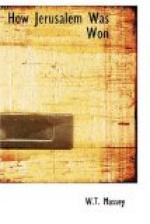[Footnote 1: See Appendix VI.]
CHAPTER VII
THE BEERSHEBA VICTORY
The XXth Corps began its movement on the night of 20-21st October. The whole Corps was not on the march, but a sufficient force was sent forward to form supply dumps and to store water at Esani for troops covering Desert Mounted Corps engineers engaged on the development of water at Khalasa and Asluj. Some of the Australian and New Zealand troops engaged on this work had previously been at these places.
In the early summer it was thought desirable to destroy the Turkish railway which ran from Beersheba to Asluj and on to Kossaima, in order to prevent an enemy raid on our communications between El Arish and Rafa, and the mounted troops with the Imperial Camel Corps had had a most successful day in destroying many miles of line and several bridges. The Turks were badly in need of rails for the line they were then constructing down to Deir Sineid, and they had lifted some of the rails between Asluj and Kossaima, but during our raid we broke every rail over some fifteen miles of track. Khalasa and Asluj being water centres became the points of concentration for two mounted divisions, and the splendid Colonials in the engineer sections worked at the wells as if the success of the whole enterprise depended upon their efforts, as, indeed, to a very large extent it did. Theirs was not an eight hours day. They worked under many difficulties, often thigh deep in water and mud, cleaning out and deepening wells and installing power pumps, putting up large canvas tanks for storage, and making water troughs. The results exceeded anticipations, and the Commander-in-Chief, on a day when the calls on his time were many and urgent, made a long journey to thank the officers and men for the work they had done and to express his high appreciation of their skill and energy.
The principal work carried out by the XXth Corps during the period of concentration consisted in laying the standard gauge line to Imara and opening the station at that place on October 28; prolonging the railway line to a point three-quarters of a mile north-north-east of Karm, where the station was opened on November 3; completing by October 30 the light railway from the east bank of the wadi Ghuzze at Gamli via Karm to Khasif; and developing water at Esani, Malaga, and Abu Ghalyun for the use first by cavalry detachments




